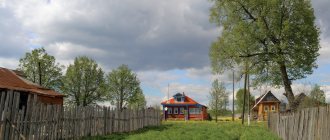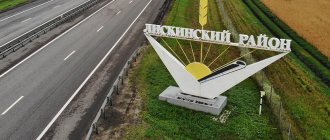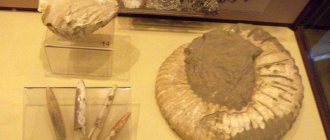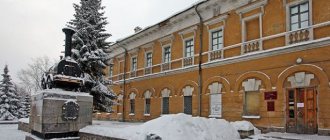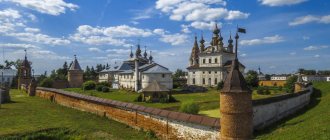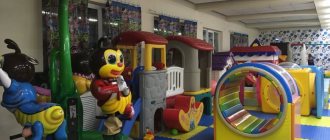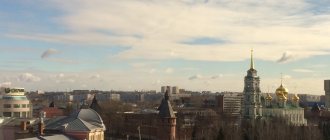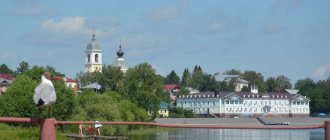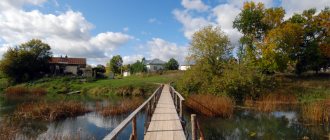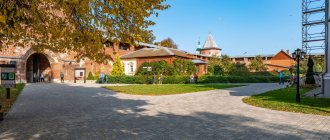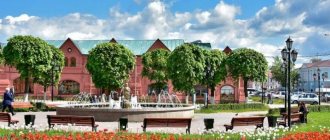What to see in Yuryev-Polsky in 1 day – TOP 3 places
Yuryev-Polsky is full of interesting sights, but among them there are three special places that are worth visiting for any tourist, even those who come here for one day.
Historical, Architectural and Art Museum (Yuryev Kremlin)
- Address: st. May 1, 4.
The richest collection of museum exhibits is located in the ancient buildings of the Archangel Michael Monastery. 16 thousand works of art and antiquities are distributed across several exhibitions. Here you can see personal belongings of aristocrats brought from their estates, exquisite porcelain items, and unique wooden sculptures.
One of the main exhibitions of the museum is dedicated to the Patriotic War of 1812. The collection consists of various evidence of the struggle of the Russian people against French troops.
Another room houses a small art gallery consisting of paintings from the 16th and 17th centuries. In the Archimandrite building you can see the works of Vladimir weavers. Guests of the city are also recommended to visit the local history exhibition, which will help to better understand the life of Yuryev residents of past years.
Honeymooners Park
- Address: 1st May Street.
Beautiful park of St. Peter and Fevronia Muromsky quickly gained popularity among both local residents and tourists. In a short period of time, several traditions have developed in the park. Lovers often meet on the Kissing Bridge, and wedding photo sessions on the Brides' Glade have become an integral part of many weddings.
Local newlyweds also like to pose near a sculptural composition in the form of crossed wedding rings with the inscription: “Advice and love.” From time to time, on the territory of the attraction you can see an unusual flower tent in the shape of a fairy-tale carriage.
St. George's Cathedral
- Address: Museum Lane.
The white-walled temple complex with a huge black dome is reminiscent of the famous Church of the Intercession on the Nerl. The cathedral has survived several eras and undergone many changes. One of the oldest churches in Russia was built in 1234 by order of Prince Svyatoslav Vsevolodovich and still remains one of the best examples of Vladimir-Suzdal architecture.
Previously, on the site of the magnificent stone cathedral there was a small church, which was founded by Yuri Dolgoruky. In each new city, the prince erected a temple in honor of his heavenly patron. Yuryev-Polsky was no exception. When the old building was damaged by an earthquake, the grandson of the great ruler Svyatoslav erected a new building, which amazed with its luxurious stone carvings.
In the mid-15th century, craftsmen from Moscow strengthened the dilapidated walls of the church and damaged the carved paintings, but managed to preserve a unique architectural monument. Cathedral of the Great Martyr. St. George the Victorious preserves ancient paintings, valuables and shrines, the main one of which is the Svyatoslav Cross. The prince made a large crucifix out of stone in gratitude to God for salvation in one of his military campaigns.
On the territory of the Archangel Michael Monastery there is the Yuryev-Polsky Historical, Architectural and Art Museum , which is open from 9.00 to 17.00, on Mondays until 15.00, closed on Tuesdays, the last Friday of the month is a sanitary day.
The document dated January 6, 1920 states that the board for museum affairs, protection of art and ancient monuments listened to the report of A.I. Romanov about his trip to Vladimir on museum business. As a result, a resolution was passed: “... to ask the executive committee to urgently provide premises for the museum..., in order to implement the resolution of the provincial congress of July 6-10, 1919.” The opening of the museum was timed to coincide with the celebration of the October Revolution - November 7, 1920. The first head of the Yuryev-Polsky art-historical and everyday life museum is 37-year-old art teacher Afanasy Ivanovich Romanov, who graduated from the Stroganov School and worked in the 1st Soviet second-level school. It was decided to place a museum in the dining room and the adjacent room of this school. A year later, all the museum property was transported to the building of the former rooms of the Khlebnikov merchants. The museum collection had grown significantly and did not fit in the small merchant rooms. And in 1922-1923. with the assistance of P.D. Baranovsky 1325 museum exhibits have already taken up residence in the former St. Michael the Archangel Monastery. Baranovsky put forward the idea of creating a museum on the basis of the monastery with the aim of preserving this highly artistic architectural complex of the 16th-19th centuries, located in the very center of the city. At this time, the museum’s funds were partially replenished from the monastery’s property. Most of the exhibits came from the former. Landowner estates of the district (Prince Golitsin, Saltykov, etc.) and private collections of manufacturers in the city of Yuryev (N. Ganshina, D. Ovsyannikov and I. Bednyakova). The rest is collected from churches and through donations. Based on the collected material, exhibitions were opened. “...a cultural and historical department is being prepared for opening, it contains objects of Finnish and Slavic culture of the 10th-11th centuries, obtained by random excavations on the territory of Yuryevsky district, a collection of ancient Russian weapons of the 11th-12th centuries, a collection of coins of the 15th-18th centuries, objects religious cult of the 17th-19th centuries, various kinds of atlases, maps. In total, there were 574 items in the first department. The art department contains paintings, sketches, and engravings in the amount of 372 items. The third department of household items is the richest and most varied in exhibits. It contains crystal, porcelain from the 18th-19th centuries, caskets, boxes, hats and lace, purses and wallets, figurines and vases. There are 673 items in total. The fourth department is natural science, just in its infancy, it contains the remains of bones of extinct animals found within the district, objects of marine flora and fauna taken from Crimea and donated to the museum.” In 1923, demolition of the warm cathedral, previously attached to the ancient St. George's Cathedral, began. The work took place under the supervision of the museum, the responsible manager of the work was the architect P.D. Baranovsky. During the dismantling of the later extensions of the cathedral (the former Trinity chapel and bell tower), 65 ancient stones with different figures and ornaments were removed. At that time, the museum was divided into the following main departments: 1) cultural and historical, 2) artistic, 3) everyday life and 4) natural. The cultural and historical department contains: objects of Finnish and Slavic culture of the 10th-12th centuries. (63 pieces), obtained by random excavations on the territory of Yuryevsky district, a collection of ancient Russian weapons of the 16th-18th centuries. (74 pcs.), collections of coins of the XV-XVIII centuries. (362 pcs.), religious objects of the 17th-19th centuries. (190 pcs.) and various kinds of atlases and maps (68 pcs.). In total, the first department included up to 574 items. In the second department - art - paintings, sketches, portraits and engravings are exhibited. Among the paintings the most valuable were: Sverchkov - “Horse in the Stable”, I. Shishkin - “Ethys”, Voroshilov - “Troika” and Makovsky - “At the Monastery”. Also noteworthy were several remarkable portraits painted by unknown artists of the late 18th century. and first floor XIX century and several engravings from the 18th century. military and religious-spiritual content. In total there are 372 items in the department. The third department, the household department, is the richest in the number and variety of exhibits. It contains: crystal and porcelain of the 18th-19th centuries. (369 pcs.), antique caskets and boxes (20 pcs.), headdresses and lace of the 18th-19th centuries. (88 pcs.), wallets and wallets (14 pcs.), figurines and vases (48 pcs.), furniture (43 pcs.), fans, playing cards (12 pcs.), chandeliers (20 pcs.), watches ( 5 pcs.) and tiles (80 pcs.). In total, the department had 679 items. The fourth department is natural science. It contains the remains of bones of extinct animals found within the county - a total of 24 specimens and 54 objects of marine fauna and flora, taken from Crimea and donated to the museum. The museum had a library with 4813 volumes, including 1840 in Russian and 2973 in foreign languages. The museum received 200-300 visitors monthly. The head of the museum from the moment of its foundation was A.I. Romanov. The first local history circle in Yuryev-Polsky was organized on the initiative of the local intelligentsia on March 6, 1924. On June 6, 1924, the circle was reorganized into the Yuryev-Polish Scientific Society for the Study of the Local Region. On September 8, 1929, Afanasy Ivanovich Romanov transferred museum objects to the newly appointed director I.I. Kadikov, a former researcher at the museum. Afanasy Ivanovich's dismissal was due to his permanent move to Moscow. The archive preserved the resolution to the report of I.I. Kadikova, pointing out shortcomings in museum work. The development of the museum business required financial investments, but the new state had not yet been formed, and only fragments remained from the old regime in the form of surviving valuables. It was difficult for the first museum workers. Even documents, orders, and memos were written on the back of old family archives of the 19th century. From December 1 to December 6, 1930, the first museum congress was held in Moscow. He demanded a decisive turn by museums to the pressing problems of the day, a radical restructuring of museum methodology on a Marxist-Leninist basis. In the surviving plans for subsequent years, the task of anti-religious propaganda was placed at the forefront. This can be seen from the original documents. The director of a 2nd-level school requests that a priest and two monks wear clothes from the museum collection for an anti-religious evening, which he undertakes to return at the end of the event. During this period, museum funds lost a colossal number of monuments of church art, which were mercilessly destroyed or used for other purposes. In 1931, Mikhail Ivanovich Orlov became director of the Yuryev-Polsky Museum. The newly appointed director becomes an active collector of archaeological and geological collections. 1920-1930 is the time when a scientific society for the study of the local region was active in the Yuryev-Polsky region, which later became the regional bureau of local history, headed by Mikhail Ivanovich Orlov. Almost all studies on local history were carried out with his participation. Their topics were very diverse. A study of geological material was carried out, the results were recorded in field diaries. The local press also reflected this. Samples of the found materials were transferred to the exhibition for display to the local population. The museum preserves a document in which Mikhail Ivanovich described the difficult conditions under which he had to work. We will briefly quote his sorrowful confession: “... the museum’s budget consists only of funds from renting out the monastery’s premises; the museum’s income does not exceed 200 rubles. per month, these funds are only enough for the guard’s salary and household expenses. There are no funds for scientific and local history work, or for hiring and paying researchers. The district executive committee refused to pay for the work of the only employee (meaning himself), and the head of the museum has not received a salary since March...” Photo portrait. Captured Orlov M.N.
M.I. Orlov conducted excursions, cleared the area in front of the museum of manure and debris, and prepared firewood for the winter. The museum is on the verge of closing. It was only thanks to the incredible efforts of Mikhail Ivanovich that it was preserved. Being a member of many societies that were emerging in the area at that time, M.I. Orlov actively promoted culture and art, and was an eloquent and competent lecturer. He argued, sometimes quarreled, with the authorities, defending the museum and its collections. Maybe that’s why he was repressed in 1936. Further traces of him were lost. During the Great Patriotic War of 1941-1945. the exhibitions were curtailed, but not for long. At the end of 1942, the museum reopened and some exhibitions were restored. The following year, due to lack of fuel, the museum was open for only 5 months. During this time, 4,800 students, adults and military personnel visited here. From 1936 and throughout the war period, the museum was headed by Fyodor Nikolaevich Poluyanov. Nothing new happened in the work of the museum during this period, but the most global task was accomplished - the museum fund was preserved. Despite the terrible military events, museum objects were protected from theft and complete destruction. Since 1953, there has been a revival in museum activities. The state pays more attention to museums, the term “tourist groups” and routes appear. The museum is expanding its staff; in addition to the director, there are two research workers - Valentina Ivanovna Dolotova and Elizaveta Georgievna Ananyina. At this time, St. George's Cathedral was shown to tourists, and work began on forming a collection of white stone. Georgy Karlovich Wagner, who worked here in the 60s of the 20th century, writes in his book “Masters of Old Russian Sculpture” that it was through the works of F.N. Poluyanov and P.D. Baranovsky, a collection of carved stones was collected and a lapidarium was built inside St. George's Cathedral. Reports by F.N. Poluyanov are full of enthusiasm, firm confidence in the future. Here is a short quote from the annual report for 1954. “...Considering that a new day in our lives brings new successes and achievements not only throughout the country, but in their area, museum workers, collecting new material, compiled thematic exhibition plans “The pre-revolutionary past of our region”, “Russian culture of the 19th century”, “Participation of the region in the Crimean War”. On March 28, 1966, by Decree of the Presidium of the Supreme Council of the RSFSR, Fedor Nikolaevich Poluyanov was awarded the honorary title of Honored Cultural Worker of the RSFSR for his services in the field of cultural and educational work. In 1968, Fyodor Nikolaevich was replaced by Zinaida Ilyinichna Kalabina, who worked as a research assistant. At this time, a restoration site is being created in the city. The museum receives assistance from local enterprises - the Avangard factory, . The restoration of the collection of paintings and icons was actively carried out. A city travel and excursion bureau opens. which helped attract tourists from the Baltic states and Leningrad to the city. Kyiv, Brest, Tashkent, Kurgan-Tube, etc. Often the museum was visited daily by 10-15 groups. By the end of the 60s, a new section “Assistance from the regional museum” appeared in museum reports. Therefore, the creation of the united state Vladimir-Suzdal Museum-Reserve was not an accidental or spontaneous decision. On May 29, 1974, the executive committee of the Vladimir Regional Council of Workers' Deputies decided to create a large museum association consisting of branches, which became museums of regional cities of the Vladimir region. It also included the Yuryev-Polsky Museum of Local Lore. This period became a period of renaissance for the museum. Then each exhibition was assigned to responsible researchers from the main museum and professional artists from Moscow or Yaroslavl. Two exhibitions created at that time exist to this day. In 1989, the executive committee of the Vladimir Regional Council of People's Deputies decided to transform the Vladimir-Suzdal Historical, Architectural and Art Museum-Reserve into the Vladimir Association of Museums, including in its composition the Vladimir-Suzdal Museum-Reserve with a branch - the Crystal Museum, and as independent museums - former branches of the united museum, including Yuryev-Polsky. Since April 29, 1990, the Yuryev-Polsky Museum has become a historical, architectural and art museum.
EXPOSITIONS
— The exhibition “Golden Calf” is the history of the local weaving factory and the tradition of artistic embroidery. — Exhibition “Peasantry and Agriculture of the Vladimir Opolye”. — Exhibition “Artistic Wood Carving” (located in the building of the Cathedral of the Archangel Michael before its transfer to the Church) - wooden sculptures of the 15th–19th centuries. - St. George's Cathedral - interior of the cathedral: stones not used in the reconstruction of the building, graves of princes and paintings of the 17th century. — Observation deck and exhibition “Monastic Cell” (in the belfry building). The exhibition consists of several narrow halls with uninteresting exhibits, and from the observation deck there is a good view of the city and the surrounding fields. — Art gallery (in the building of the Church of St. John the Evangelist) – Russian art of the 16th–19th centuries. — An exhibition dedicated to the life of P.I. Bagration - a museum of the famous commander of the Patriotic War of 1812.
Observation deck and exhibition “Monastic Cell” in the bell tower building
The exhibition consists of several narrow halls with uninteresting exhibits, and from the observation deck there is a good view of the city and the surrounding fields.
Vladimir residents in the war of 1812. P.I. Bagration - national hero of Russia
Banner of the Astrakhan Regiment. 1812
People's weapons
Signal gun. Early 19th century
Guns. Jaeger fitting. Beginning of the 19th century.
The great Russian commander Pyotr Ivanovich Bagration, after being wounded near Borodino, was transported to the estate of his relative Princess Golitsyna near Yuryev-Polsky...
A carriage from the estate of the princes Golitsyn in Sima
Furniture, household items XVIII - early. XIX centuries from the Golitsyn house in the village of Sima, where the wounded P.I. was treated. Bagration
The art part of the museum contains: paintings, religious objects, dishes, porcelain from the homes of local citizens who had paintings and porcelain before the revolution.
Museums of the Vladimir region.
House-Estate of the Golitsyns in the village of Sima.
HISTORY of the Vladimir region.
Interesting places in the vicinity of Yuryev-Polsky
In the vicinity of the city of Yuryev-Polsky, tourists will find many picturesque places, remarkable for their history and natural landscape.
Earthen ramparts (Mstislavl settlement)
- Address: s. Settlement.
The grassy earthen ramparts of Mstislavl are the main mystery of the area, hills that attract treasure hunters and lovers of mysticism. Over the course of several centuries, the once flourishing city was completely destroyed and wiped off the face of the earth. Having fallen victim to the Tatar-Mongol yoke, Mstislavl lost its former greatness and finally disappeared during the years of Soviet power. Now only hills, a deep ditch and the ruins of the Church of the Nativity remind us of the ancient city. The church was destroyed during the Soviet Union and now only the dilapidated four-tiered bell tower rises alone over the meadows.
Golitsyn Estate
- Address: s. Sima.
The estate in the village of Sima, Yuryev-Polsky district, became famous thanks to several famous families. The small village is a gift to General Mikhail Golitsyn from Peter the Great, a reward for military merits. Having received the land into possession, Mikhail Mikhailovich ordered to build a house with outbuildings on it, plant a park and dig a pond.
The history of the estate is also closely connected with the fate of the great commander Peter Bagration, a relative of the Golitsyns. After being seriously wounded in the fields of Borodino, the general came to Sima, where he spent his last days before his death. The commander's body was buried near the village church of St. Demetrius of Thessalonica, but was later reburied.
After the Revolution, the noble estate became a shelter for orphans. Currently, the manor house houses a library and a museum named after. P. Bagration and the local House of Culture.
Apraksin Estate
- Address: s. Ratislovo.
The once rich 18th century manor has only partially survived. Before the Revolution, there was a tall manor house, two outbuildings for servants and the Kazan Church. A large park was laid out for the Apraksin nobles, containing eight fairly large ponds. Of all the buildings, today you can only see the main house, which has lost its former beauty. The double building housed the school. Tourists can stroll through the wonderful park and admire the ponds.
Church of the Nativity and Boris and Gleb Church
In the inventory of the city of Yuryev-Polsky in 1613 and 1760. the Church of the Nativity is not mentioned; therefore, its foundation can only be dated to the end of the 18th century. In 1792, the cold stone church was consecrated in honor of the Nativity of Christ, with chapels in the name of the holy wonderworkers, unmercenaries Cozma and Damian, and in the name of the holy great martyr Paraskeva. The lane in which the temple stood was called Kokushkin and Kozmodemyansky. It received its last name from the temple, which local residents knew better as Kosmodamiansky, after the dedication of one of the chapels. There is an assumption that initially the entire temple was consecrated in honor of Cozma and Damian, and only after the addition of the bell tower was it reconsecrated in the name of the Nativity of Christ.
Church of the Nativity of Christ in Yuryev-Polsky
The Church of the Nativity of Christ is a relatively low quadrangle, topped with five large drums with onion-shaped domes. Attached to the quadrangle was a low refectory with a three-tiered massive bell tower, on which there was even a clock. The quadrangle of the temple is decorated with false zakomaras in the upper part, and all facades are divided into three parts by small blades. The already high drums are raised by the kokoshniks surrounding each drum. The bell tower was completely destroyed during Soviet times. Currently, the Church of the Nativity of Christ is active. In 1808, a warm stone church was built in honor of the holy princes-passion-bearers Boris and Gleb.
Boris and Gleb Church
Yuriev-Polsky monasteries and monasteries
On the territory of Yuryev-Polsky and its environs there are several monasteries, whose fate is closely intertwined with the history of Russia.
St. Vvedensky Nikon Monastery
- Address: Kalanchevsky Lane.
Historians cannot say exactly when the Holy Vvedensky Monastery was built. The first written mentions of the convent date back to the first half of the 17th century. It is believed that the Nikon Church was built on the site of the house where St. Nikon of Radonezh, the spiritual son and disciple of St. Sergius of Radonezh, was born.
At the beginning of the 18th century, a fire destroyed two monastery churches, leaving only St. Nicholas Church. Half a century later, on the site of the burnt wooden buildings, the stone Vvedensky Cathedral with stucco “kokoshniks” above the windows and neat carvings arose. A little later, the temple was complemented by a four-tier high bell tower - the tallest building in the city.
The fire of 1871 disrupted the quiet life of the monastery. All buildings were in disrepair, which is why the continued existence of the monastery was in jeopardy. The nuns and novices were moved to the parish of the Church of Peter and Paul, where over time the Peter and Paul Monastery was formed.
Under the Bolsheviks, the Holy Vvedensky Monastery was finally abolished, the beautiful bell tower was destroyed, and the spacious church premises were used as warehouses. Today the monastery is being restored after numerous upheavals of the 20th century, already in the status of a male monastery complex.
Michael the Archangel Monastery
- Address: Yuryevsky Kremlin.
One of the oldest communities in Russia and a real architectural reserve, the Archangel Michael Monastery is both an active monastery and the main museum of the area.
The monastery grew up on the ramparts of the more ancient Yuryev-Polsky Kremlin. It is believed that the monastery was founded by Prince Svyatoslav Vsevolodovich. The first monastery buildings from the 13th century have not survived; the earliest buildings date back to the mid-17th century. The most valuable buildings from the point of view of history are the Znamenskaya refectory church, the tented bell tower and the gate church of St. ap. John the Theologian. The main cathedral of the Archangel Michael, as well as the archimandrite and fraternal buildings were built in the 18th century.
The history of the monastery is very tragic. Due to its geographical location, Yuryev-Polsky repeatedly found himself in the path of invaders marching on Moscow and was attacked by enemies. Along with the entire city, foreigners also destroyed the Archangel Michael Monastery. The long-suffering monastery literally rose from the ashes four times. Over the years, the khans Batu, Tokhtamysh and Edigei sought to destroy Orthodox churches, burned buildings, and killed the monastic brethren. In the 17th century, similar misfortunes were brought about by Polish invaders.
The last serious test for the monastery was anti-church persecution during the Soviet period. The monastic community was banned, and the buildings housed museum exhibitions that are still open to this day. Currently, monastic life is being resumed on the territory of the museum, and services are again held in the Church of St. Michael the Archangel.
Monastery of St. ap. Peter and Paul
- Address: Krasny Poselok quarter.
According to some sources, the Peter and Paul Convent was founded back in the 16th century, but all known stone buildings date back to the 19th century. The center of the monastery was the Cathedral of Peter and Paul, and the Church of the Assumption of the Blessed Virgin Mary stood nearby. Several decades later, the temples fell to the communists; only the luxurious five-tiered bell tower survived. The monastic lands were transferred to the Krasnoselsky state farm. In 2010, the revival of the monastery began. Only the walls of the old churches remain, so services are held in the former cemetery Church of the Ascension of the Lord.
St. Nicholas Monastery
- Address: Novoe village, 11.
The convent is located not far from Yuryev-Polsky - in the village of Novoe. Stone Church of St. Nicholas of Myra grew up in 1826 on the site of an old wooden building. Initially it was a simple parish church. In Soviet times, the Church of St. St. Nicholas the Wonderworker was one of two regional churches that escaped closure and destruction.
Knowing this, believers brought church valuables here. The church became the custodian of the five great shrines of the region - the miraculous icons of the Blessed Virgin Mary. In the 70s, a small community of several secret nuns formed in the parish. In 1995, the community received a bishop's blessing and began to officially be called a convent.
Vvedensky Nikon Monastery
Before the foundation of the Vvedensky Monastery, the parish wooden Alekseevskaya Church stood in its place. The exact date of foundation of the monastery is unknown, but the wooden church in the name of St. Nicholas the Wonderworker is mentioned in the patriarchal books of 1628. In 1666, the first stone church of the monastery was built in the name of St. Nikon of Radonezh, since, according to legend, the house of St. Nikon’s parents stood on the site of the monastery. During the fire of 1710, the wooden church of St. Nicholas and the oldest of the monasteries, the wooden cathedral church of the Entry of the Blessed Virgin Mary, were destroyed. In 1763-1766 the church was rebuilt. In 1785, the monastery was surrounded on three sides by a stone fence, and on the fourth, northern side, for some reason, a wooden fence was installed, which was replaced with a stone fence only in 1856. In 1811-1826, instead of the dilapidated cathedral bell tower, a new, four-tiered one with a gate was built. The monastery, tightly sandwiched between residential areas, burned repeatedly. After this, it was decided to abolish the monastery and transfer the nuns to the Peter and Paul Church. The churches were restored after the fire and became parish churches. After the revolution, the churches of the Vvedensky Nikon Monastery were closed, and they housed a warehouse with workshops, and then for a long time the buildings were occupied by a bakery. On December 24, 2000, the monastery was reopened as a monastery. Restoration work is underway on the territory of the revived monastery, and therefore the approaches to the monastery are limited.
View of the city from the bell tower of the Archangel Michael Monastery
Temples and churches of the city
Yuryev-Polsky, like every ancient Russian city, is rich in churches. Many priceless examples of ancient architecture have survived to this day.
Church of the Nativity
- Address: per. Avant-garde.
The Church of the Nativity forms a single complex together with the Boris and Gleb Church. Services in the spacious five-domed Church of the Nativity of Christ took place in the summer, while the younger Church of Boris and Gleb was used during cold weather. The latter was significantly smaller in size, making it easier to heat. The low temple with small windows retained heat even in severe frosts.
During the Soviet years, both churches were looted and converted into dairy factory workshops, which greatly damaged the ancient buildings. The bell tower was dismantled to its foundations. After the collapse of the Union, restoration work began, which continues successfully to this day.
Church of the Life-Giving Trinity
- Address: st. May 1st.
One of the youngest temples in the city surpasses many ancient religious buildings in its scale and splendor. The luxurious red-brick cathedral with lush decoration in neo-Russian style marked the three-century anniversary of the Romanov dynasty. The temple did not last long; two years after the opening, the Revolution took place. The Soviet government did not spare the architectural masterpiece: the cathedral was beheaded and closed, church values disappeared without a trace. Several years ago the church was transferred to the Archangel Michael Monastery. At the moment, the cathedral is undergoing restoration.
Church of St. Nikita Martyr
- Address: st. Pokrovskaya.
The small, but very beautiful and cozy Nikitskaya Church was built at the end of the 18th century. The classic building attracts attention from afar thanks to the bright combination of white, red, green and blue colors. The outside of the building is decorated with antique porticoes with columns. The drum is dotted with numerous windows, thanks to which the inside of the temple is well lit even in cloudy weather.
The Temple of Nikita the Martyr was able to survive when the Bolsheviks came to power, but was closed at the beginning of the Great Patriotic War. A car repair shop opened on the premises. Where once there had been chants and the scent of incense, there was now the sound of metal clinking and the smell of exhaust fumes. In the year of the 1000th anniversary of the Baptism of Rus', the building was returned to the Church and completely restored. Today the church is open to believers.
St. George's Church (wooden)
- Address: Yuryevsky Kremlin.
A small log church of an unusual shape was built in the village of Yegorye (Egoriy) at the beginning of the 18th century. Talented architects created a temple without nails, using only axes. According to some sources, the church belonged to the St. George Monastery of the mid-16th century, which ceased to exist several centuries ago. In the mid-20th century, the building was transported to the Archangel Michael Monastery. A few meters from the church there is a small Nadkladeznaya chapel. A wooden chapel covers a well filled with water from a holy spring.
Intercession Church
- Address: st. Embankment.
The modern stone Church of the Intercession of the Blessed Virgin Mary stands on the site of a burnt wooden church built in 1712. According to the plan of its founder, monk Kirill, the temple was to become the center of the Intercession Convent, but the monastic community lasted only a few years. The nuns moved to the Holy Vvedensky Monastery, and the church became a simple lay parish.
After some time, a fire incinerated the wooden building. The new stone structure was erected in one year with donations from local residents. Already in 1769, the church opened its doors to parishioners.
In the 19th century, the temple was decorated with a magnificent three-tier bell tower with stained glass windows. After the Revolution, the architectural monument was turned into a workshop. In the 90s the temple was returned to the Church. Nowadays, many pilgrims from all over the country come to the Intercession Church to venerate the relics of the holy noble prince Svyatoslav Vsevolodovich, found shortly before the revival of the church.
Trinity Church in the village. Podolets
- Address: Podolets village.
The unique two-tier temple was erected in 1659 on the estate of the princes Miloslavsky. Inside there were four chapels: the Life-Giving Trinity, St. Joachim and Anna, ap. Andrew the First-Called and St. Mary of Egypt. Several members of the noble family are buried in the lower temple. The USSR did not appreciate the splendor of the church, and for many decades the ancient building was destroyed under the influence of natural elements. Today, thanks to the work of restorers, the temple has received a chance for a new life and is slowly being restored.
Architecture and beautiful buildings
Yuryev-Polsky is a place of contrasts. Typical five-story buildings alternate with ancient buildings, thanks to which you can trace the development of urban architecture from ancient times to the present day.
Shopping arcades
- Address: pl. Soviet.
Trading premises, traditional for many Russian cities, appeared in Yuryev-Polsky in the 18th century. A hundred years later, a strong fire destroyed the wooden buildings, and soon a new building arose in their place, which has survived to this day. The Yuriev-Polsky ranks made a small contribution to domestic cinema: in the 60s of the last century, the film “The Golden Calf” with S. Yursky in the title role was filmed here. While walking along the Trade Rows, tourists can do two pleasant and useful things at once - examine the architectural monument and buy the necessary goods in the shops located in it.
Barn
- Address: per. Avangardsky, 3.
The unremarkable red building made of simple brick is an architectural monument of the 19th century. For a long time, merchant goods were stored here, but during the years of “dekulakization” the building was recognized as socialist property and turned into a city warehouse.
Fire station
- Address: Vladimirskaya st., 12.
The interesting brick building in the Gothic style has been well preserved despite its hundred years of age. The depot has been used for its intended purpose at all times, under any government. In some rooms dance evenings and theatrical performances were held, in others fire engines were waiting to be called. The gray building with its unusual shape stands out among other city buildings.
Almshouse of the Meshcherins
- Address: st. May 1st, 16.
The remarkable two-story red brick building was erected at the beginning of the 20th century with the money of local philanthropist G.I. Meshcherina. The almshouse accommodated more than 150 people of both sexes, mainly townspeople and old merchants. Currently, the former almshouse continues to benefit people: the central hospital of the region operates in the building.
Shevelkin Inn
- Address: 1st May Street, 33.
Good, memorable photos are also taken against the backdrop of this architectural landmark of Yuryev-Polsky. The building of the Shevelkins' inn was built approximately at the end of the 19th century, in the form of a two-story building with a blue and white facade and beautiful, bordered windows. The entrance is crowned by a pretty porch.
Khlebnikov's shop
- Address: st. 1st May, 4.
In the central part of the city, almost every building is an object of cultural heritage of municipal or federal significance. So is the former Khlebnikov Shop, built in the 19th century and a decoration of the city limits. As before, today there is a store offering food products here.
Monuments and memorial complexes
The monuments of Yuryev-Polsky are in one way or another connected with its rich history, however, as in other cities of the Central District, for example, Vladimir or Ryazan .
Monument to Yuri Dolgoruky
- Address: Vladimirskaya street.
The granite prince surveys his creation from a high pedestal on the main square of the city. The sculpture of the founder was installed in 2002. next to the current Honeymooners' Park. The founder of the city is depicted in full height, with majestic posture. With one hand he leans on the sword, with the other he holds a flowing cloak. Behind Yuri Dolgoruky are the domes of the Archangel Michael Monastery. At the foot of the pedestal, two stone lions bare their teeth - a symbol of power, courage and nobility.
Soldiers' Memorial
- Address: 1 May Street.
In a small park next to the Historical and Art Museum there is a white monument to all the soldiers and officers who died in the Great Patriotic War. On the right side of the sculptural composition, stern warriors are depicted, on the left - inconsolable mothers and wives. Men and women are separated by a grave stele topped with a star. The inscription on the monument reads: “No one is forgotten, nothing is forgotten.” The Eternal Flame is lit in front of the memorial. The monument conveys the grief of the residents of Yuryev-Polsky: out of 11 thousand townspeople, 8 thousand did not return from the war.
Monument to those killed in the Second World War
- Address: Naberezhnaya street.
Another memorial dedicated to the Great Patriotic War. The composition consists of five parts. In the center, on the gray monuments, a red granite star is burning, under it is a slab of the same material, repeating the shape of the Yuryev-Polsky region. The inscription on the plate reads: “Dedicated to our fellow countrymen.” On both sides there are four gray slabs with plaques, which indicate by name each Yuryevite who was awarded the title of Hero of the Soviet Union. Every year fresh flowers are laid at the memorial.
Monument to doctors
- Address: Central District Hospital district.
A modest monument was erected next to the Central Regional Hospital. The dark stone depicts a golden star in a wreath. The monument is dedicated to all medical workers, doctors and nurses who died at the hands of the German invaders during the Great Patriotic War.
Monument to the 850th anniversary of the city
- Address: 1 May Street.
A stone worship cross was erected near the walls of the Archangel Michael Monastery in the anniversary year of 2002. The monument is a tribute to the centuries-old history of the settlement, its rich Orthodox culture and the difficult trials that befell the local residents.
Topic: The best attractions of the Vladimir region
Trinity Cathedral of the early 20th century
The Cathedral of the Life-Giving Trinity in Yuryev-Polsky was built next to the ancient St. George Cathedral, between it and the St. Michael the Archangel Monastery. Construction began in 1907. Work on the construction of the new temple took seven years, and by 1914 the building was completed. The consecration of the temple was somewhat delayed and took place only in 1915. Trinity Cathedral was built in a pseudo-Russian style, decorated with rich decor reminiscent of ancient Russian pattern carvings. During Soviet times, the cathedral was closed and disfigured, and chapters were demolished. It doesn't work now.
Trinity Cathedral in Yuryev-Polsky
Where to go in Yuryev-Polsky with children
For a child, there is, frankly speaking, very little entertainment in the city of Yuryev-Polsky. But you can still find a place where children will have fun.
Children's entertainment
- Address: Krasnooktyabrskaya st., 1A.
In the city center, next to the City Market, this leisure center offers some memorable activities for children. The townspeople regularly bring their hell here, judging by the reviews, because in fact there are few such facilities here. Children are brought here with their parents so that they can look after their children. Soft blocks, small trampolines, inflatable slides, a dry pool with toys - all this is waiting for your child.
Victory Park
Photo: © https://maps.google.com/maps/contrib/109502934084084867793
- Coordinates on the map: 56.508516, 39.664045.
Probably the most famous public garden in the city, its only competitor - the Ganshin City Estate Park - offers practically nothing for family recreation, presenting a pitiful sight. However, in Victory Park there is also not much interesting for children. But here, on the banks of the beautiful Koloksha River, the breath is simply amazing, and the photos against the backdrop of natural beauty are memorable.
See also the sights of other cities of the Vladimir region - Alexandrov, Kirzhach, Petushkov, Sudogda, Kolchugino, Kidekshi, Vyaznikov, Bogolyubovo, Murom and Suzdal
Yuriev-Polsky is a reflection of different eras. Like an ancient elder, he wisely looks at modernity and invites you to take a break from the external bustle, to reflect on the passage of time and your existence in the vast world. Yuryev-Polsky is perfect for everyone who wants to dive into the depths of centuries and look at life with different eyes.
